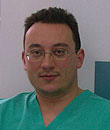Introduction
Doctor-patient interaction in primary care is fundamental to a functioning health system1,2. In Europe, primary health care has been articulated for well over a decade, yet it has not become part of the routine practice of family medicine; however, recent surveys indicate that patients prefer receiving health information from primary care physicians3. In the UK, the GPs' contract defines the nature of the relationship between family doctors and the government4. Patients' main demands refer to shorter waiting times5,6 and personal continuity in care provider7,8. In Greece, the Health Care Act was reformed some years ago to support primary health care in urban areas, but the reform has not been enacted. In Athens hospitals a long emergency department (ED) waiting time is common; therefore, providing 24 hour urban primary care centers would be a milestone in the radical reform of the health system. This study evaluated cases treated in hospital and explored the role that primary care could have had in the initial treatment of those cases.
Methods
Medical records for patients attending the Laikon University Hospital ED, Athens, between February 2005 and February 2006 during on-call days (24 hours every 4 days) were evaluated. The total number of patients who visited the ED was classified into 6 groups, according to their main complaint: (i) internal medicine; (ii) surgical; (iii) orthopedic; (iv) otorhinolaryngology (ENT); (v) eye clinic (ophthalmology); and (vi) gynecology-obstetrics. Each case was reviewed with respect to the necessity for hospital rather than GP attendance.
Results
During the on-call days, 53 926 patients visited the ED; their mean age was 65.6 years. Of the total number, 9167 patients (17%) came from a rural area and visited the hospital with or without a referral. Due to the shortage of GPs in Greece (there are approximately 1000 GPs instead of the 27 000 required) the referring doctors were mainly physicians working in the private sector.
The internal medicine outpatient department was most commonly attended (15 373 patients, 28.5%). Of these, 54% were female and 922 patients (6%) came from a rural area. The main reason for seeking care in the internal medicine department was fever (3536 patients, 23%) and 1845 patients (12%) complained of abdominal pain. Gastrointestinal hemorrhage was observed in only 3% (462 patients) and 1230 patients (8%) suffered from nausea, vomiting and diarrhea. Chest pain (n = 2, 5%) and shortness of breath (2%) were observed less often. Admission was necessary for only 1845 patients (12%).
The surgical outpatient department was visited by 10 543 patients (19.5%). Of these, 6431 were male (61%) and 316 patients (3%) lived in a rural area. Among these patients 2425 (23%) suffered from injuries not necessitating hospital care and could have been treated by a GP. The most common injuries were lacerations (2425 patients, 89%), followed by animal bites (7.7%) and skin abrasions (3.3%). In total, 86% of the injuries were treated with sutures, and 14% with cleaning the wound and bandaging. Only 190 patients (1.8%) presenting to the emergency surgery outpatient department required hospital admission.
In the orthopedic outpatient department 9152 patients (16.9%) were admitted, with 56% being male. Among these patients, 3679 (40.2%) were considered appropriate for treatment by a GP for the following complaints: (i) ankle joint injury (9.2%); (ii) back pain (16.5%); (iii) neck pain (2.2%); (iv) wrist joint injury (3.1%); (v) knee joint injury (7.7%); and (vi) muscle lacerations (1.5%). Almost all cases (94%) underwent X-ray examination but only 1.3% (119 patients) required hospital admission. Of those visiting the orthopedic outpatient clinic 13.9% were treated with application of plaster or fiberglass casts. The number of patients from a rural area was 824 (9%).
In the ENT department 7551 patients (14%) were examined (51% females), with 529 (7%) being from a rural area. Inflammatory/infectious diseases accounted for 36.4% (19 629 patients), the most common of these being tonsillitis (12%), followed by pharyngitis (11.2%), external otits (5.4%) and sinusitis (4%). Less frequent was laryngitis (1.5%), parotitis (1.2%) and stomatitis (1.1%). All these patients could have been managed by a GP without referral to a specialist or undergoing hospitalization. An X-ray examination was conducted in 725 patients (9.6%) and only 191 patients (1.4%) were admitted to hospital. Antibiotics were administered to 27.5%.
In the ophthalmology outpatient department 7351 patients (13.6%) were examined (46% female), and this department had the highest percentage of visitors from a rural area (735 patients, 10%). Of the total number of cases presenting as an eye emergency 32.5% were appropriate for GP care. These included conjunctivitis (9.9%), conjuctival foreign body (7.9%), injuries (5.9%), inflammatory conditions(4.8%), scalds (4%) and inner hordeolum (2.7%). Re-examination after 24 hours was necessary in 2360 patients (32.1%), and admission was only necessary for 272 patients (3.7%).
The gynecology-obstetrics department was visited by 3956 patients (7.33%), with 198 of those being from a rural area. Of these, 27.6% could have been treated by a GP and concerned: (i) pelvic pain (10.3%); (ii) vaginal bleeding (1.5%); (iii) itching of the inner and outer genitalia, dysuria and vaginal secretions (10.6%); and (iv) pregnancy testing. Ultrasonography and a physical examination were performed on the patients suffering from pelvic pain. Urinalysis and culture were performed for patients with itching of the inner and outer genitalia, dysuria and vaginal secretions. In 1662 patients (42%) a Pap smear was taken. Admission was required for 127 (3.2%) of all gynecology patients.
Discussion
Twenty-four years after the establishment of the Greek National Health System, very few of the planned 210 health centers are operating in urban areas9, and public hospital functioning remains problematic. Long waiting times and associated limitations to accessing specialized care, particularly in hospital outpatient departments, is one of the most frequent problems10.
Health centers in rural settings do not have appropriate equipment and this results in public dissatisfaction. In the present study, approximately 20% of patients seeking treatment at an urban ED came from a rural area. Current studies indicate that increased availability of primary health care is associated with higher patient satisfaction and reduced health spending11,12. Although some surveys13 indicate a preference among patients for hospital attendance, the main reason for this is a combination of ignorance and GP inaccessibility. Patients approaching hospitals for acute problems do so only because they believe hospital attendance is essential to accessing the personnel and equipment needed for their care (eg for suturing lacerations). A more functional primary care system could change such public perceptions.
Retrospective studies indicate that one- to two-thirds of patients attending accident and emergency departments suffer from diseases that could be managed by a GP14-17. The identification of patients with non-emergency problems (eg lacerations, minor injuries, infectious diseases, fractures, fever, or nausea,vomiting and diarrhea) and diverting them to well equipped primary care centres would assist the health system to function more efficiently. In the present study, 3% of surgical patients (n = 316) and 6% of internal medicine patients (n = 922) came from a rural area and most of these could also have been treated at a health center. In addition, for the significant number of patients visiting the ED suffering from inflammatory/infectious diseases, the continuity of care required to ensure treatment compliance would best be provided by a GP18. By bringing together public health and primary care in Greece, overall service quality would be improved.
Most healthcare systems are re-organized to compensate decreasing financial resources. In European countries a gate-keeping role has been implemented for GPs to increase efficacy and reduce costs14. The present study also suggests that GPs, especially those in rural areas, should be trained to manage procedures such as removal of foreign bodies from the eye, urinalysis, pregnancy tests and Pap smears.
This study indicates a 'practice-based curriculum' should be developed to improve GP professional standards, and the role of the GP within the health system should be re-appraised. A properly organized health center with well-trained GPs would assist a change in public perceptions about the preferred site of care. Such promotion of primary care would provide an opportunity for the development needed to overcome the current disadvantages in the existing Greek health system.
References
1. Dunlop AL, Jack B, Frey K. National recommendations for preconception care: the essential role of the family physician. Journal of the American Board of Family Medicine 2007; 20: 81-84.
2. Moos MK, Cefalo RC. Preconceptional health promotion: a focus for obstetric care. American Journal of Perinatology 1987; 4: 63-67.
3. O'Donnell M, Viktrup L, Hunskaar S. The role of general practitioners in the initial management of women with urinary incontinence in France, Germany, Spain and the UK. European Journal of General Practice 2007; 13: 20-26.
4. Lionis C, Tsiraki M, Bardis V, Philalithis A. Seeking quality improvement in primary care in Crete, Greece: the first actions. Croatian Medical Journal 2004; 45: 599-603.
5. Baker R, Streatfield J. What type of general practice do patients prefer? Exploration of practice characteristics influencing patient satisfaction. British Journal of General Practice 1995; 45: 654-659.
6. Linn LS, Brook RH, Clark VA, Davies AR, Fink A, Kosecoff J. Physician and patient satisfaction as factors related to the organization of internal medicine group practices. Medical Care 1985; 23: 1171-1178.
7. Jung HP, Wensing M, Grol R. What makes a good general practitioner: do patients and doctors have different views? British Journal of General Practice 1997; 47: 805-809.
8. Grol R, Wensing M, Mainz J, Ferreira P, Hearnshaw H, Hjortdahl P, Olesen F, Ribacke M, Spenser T, Szecsenyi J. Patients' priorities with respect to general practice care: an international comparison. European Task Force on Patient Evaluations of General Practice (EUROPEP). Family Practice 1999; 16: 4-11.
9. Tountas Y, Karnaki P, Pavi E. Reforming the reform: the Greek National Health System in transition. Health Policy 2002; 62: 15-29.
10. Linnala A, Aromaa A, Mattila K. Specialist consultations in primary health care - a possible substitute for hospital care? Health Policy 2006; 78: 93-100.
11. Starfield B, Shi L, Macinko J. Contribution of primary care to health systems and health. Milbank Quarterly 2005; 83: 457-502.
12. Yallop JJ, McAvoy BR, Croucher JL, Tonkin A, Piterman L. Primary health care research - essential but disadvantaged. Medical Journal of Australia 2006; 185: 118-120.
13. Myers P. Management of minor medical problems and trauma: general practice or hospital? Journal of the Royal Society of Medicine 1982; 75: 879-883.
14. Bedford HE, Jenkins SM, Shore C, Kenny PA. Use of an east end children's accident and emergency department for infants: a failure of primary health care? Quality in Health Care 1992; 1: 29-33.
15. Green J, Dale J. Primary care in accident and emergency and general practice: a comparison. Social Sciences and Medicine 1992; 35: 987-995.
16. Dale J. Primary care: the old bugbear of accident and emergency services. British Journal of General Practice 1992; 42: 90-91.
17. Cohen J. Accident and emergency services and general practice - conflict or cooperation? Family Practice 1987; 4: 81-83.
18. Barr DA. The effects of organizational structure on primary care outcomes under managed care. Annals of Intern Medicine 1995; 122: 353-359.







